I love drawing fish because of their beauty and grace. Their movements, scales, and underwater world inspire me. If you want to learn how to draw a fish, I’ll show you a simple way.
This tutorial will guide you through nine easy steps to draw a fish. We’ll start with the basic shape and add details to make it come alive. This guide is for everyone, whether you’re new or experienced.
Let’s start learning how to draw a fish. You’ll be amazed at how easy it is. Get ready to impress your family and friends with your art.
Introduction to Drawing Fish Basics
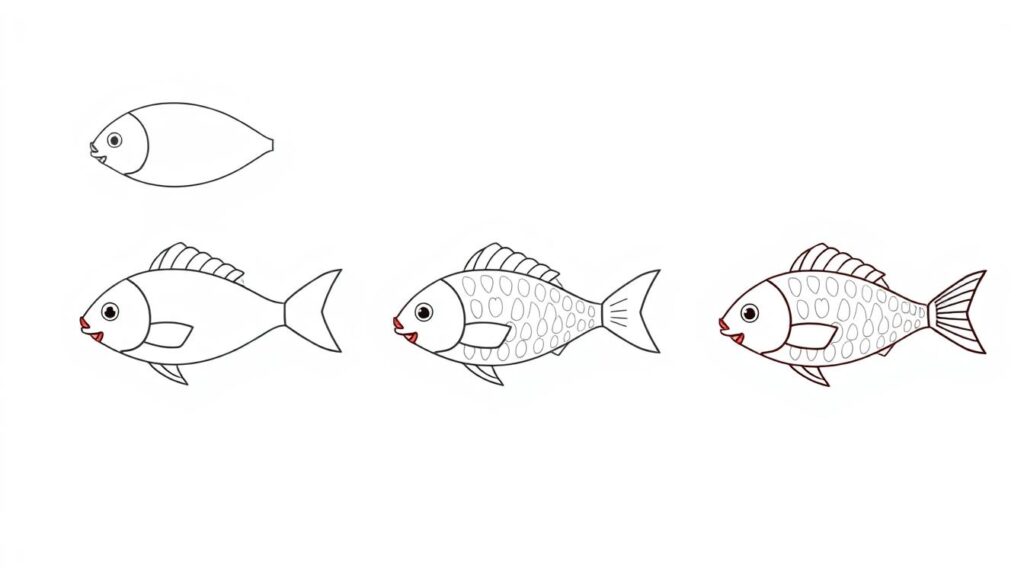
Learning to draw fish starts with knowing their basic anatomy. This knowledge is key for creating fish drawings that look real and engaging. It makes the step-by-step fish drawing process easier and more fun.
Fish have a special body shape that helps them swim well. Their head, body, and tail work together. This makes their swimming look smooth and natural. By focusing on these features, you can draw fish that seem to move and look real.
| Anatomical Feature | Description |
|---|---|
| Body Shape | Fish have a long, narrow body shape. This helps them swim fast and efficiently. |
| Fins | The fins on a fish are important for swimming and staying stable in the water. |
| Scales | The scales on a fish’s body protect it and make it look sleek. |
Knowing the basics of fish anatomy helps you draw them better. With practice, you’ll get good at making simple fish art. Your drawings will show off your talent and creativity.
Preparing Your Drawing Materials
Before starting your basic fish sketching journey, gather the right materials. This fish doodle guide suggests using a simple pencil. It’s great for making mistakes and then erasing them.
The guide shows how to draw a simple fish in 4 easy steps. So, a basic pencil is all you need to start.
The practice sheet in this guide offers 5 more ways to draw fish. It encourages you to try different styles. You can print out the sheets to share with family, Sunday School, or your classroom. It’s a fun way to learn to draw fish together.
After mastering basic fish sketching, you can add color. Use markers, Crayola crayons, oil pastels, or color pencils. This fish doodle guide is versatile. It has easy tutorials for drawing manatees, pigs, goats, birds, owls, dogs, and frogs.
Remember, the key to successful basic fish sketching is having the right materials and practicing. With this guide, you’ll soon be creating beautiful fish drawings!
Step-by-Step Guide to Drawing a Fish
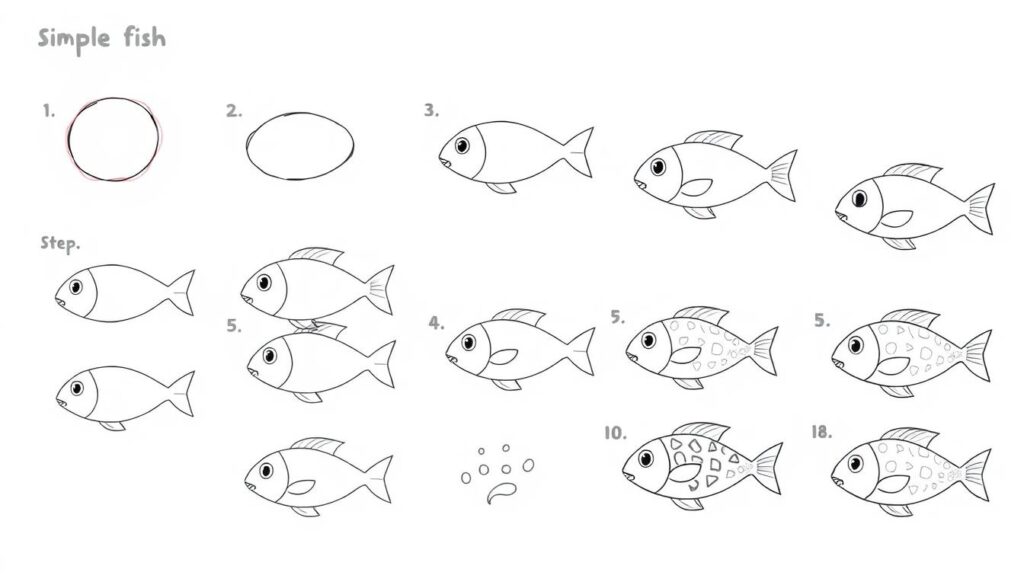
Unleash your inner artist and learn to draw a fish with this easy tutorial! It’s perfect for beginners or those who want to improve their fish drawing skills. You’ll learn to use simple shapes and techniques to create a stunning fish drawing.
First, gather your supplies. You’ll need an H pencil for the initial sketch, an HB pencil for details, and a 4B pencil for depth and shadows. A kneaded eraser is also essential for perfecting your drawing.
Start by drawing the fish’s body using circles and triangles. Then, add the fins, eyes, and other features. Pay special attention to the spiny dorsal fin, as it’s key to bringing your fish to life.
Next, focus on shading and detailing to make your fish look real. Use different pencils to achieve the right effects. Start with the lighter H pencil for sketching and the darker 4B for shadows.
With patience and practice, you’ll master drawing fish. This guide is great for beginners and kids, helping you create fun fish art projects. So, grab your pencils and start exploring marine-inspired creativity!
Learn more about drawing fish and discover the joy of creating marine-inspired art.
Refining and Detailing Your Fish Drawing
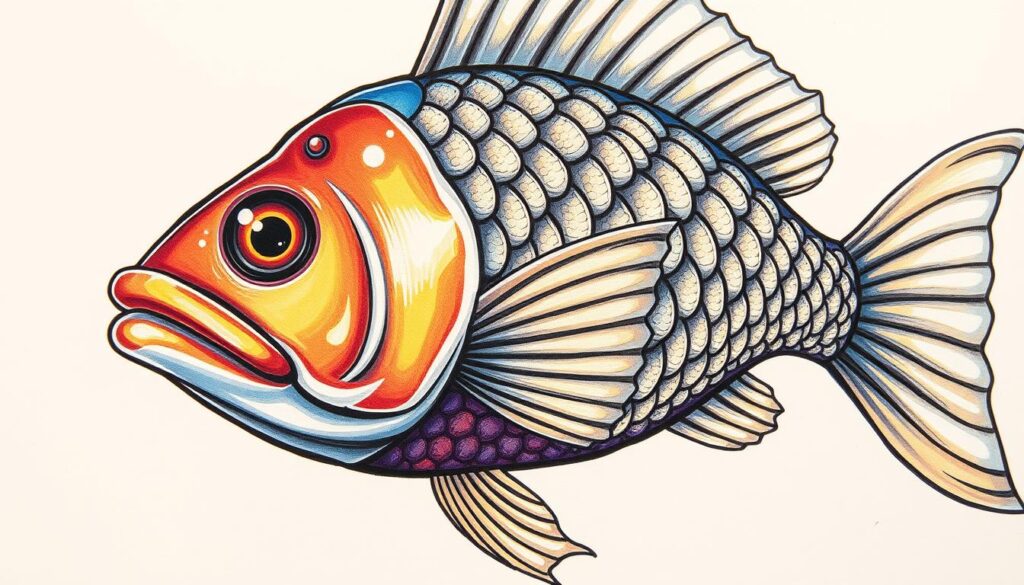
After you’ve drawn the basic outline of your fish, it’s time to add more details. Drawing marine life well means paying close attention to every detail. This step is key to making your fish drawing look professional.
Begin by smoothing out any rough lines with a clean eraser. Make sure your fish’s body, fins, and other parts are in proportion. This will make your drawing look more realistic and balanced.
| Drawing Technique | Description |
|---|---|
| Blending | Use a blending stump or your finger to softly blend the pencil marks, creating a smoother transition between shaded areas. |
| Hatching | Draw a series of parallel lines to add texture and depth to your fish’s scales, fins, and other details. |
| Stippling | Apply small, evenly spaced dots to create a subtle shading effect and add interest to your drawing. |
Remember, the secret to fish drawing basics is to take your time. Focus on the unique features of your subject. By refining and detailing your fish drawing, you’ll make your artwork more lifelike and engaging.
Coloring and Shading Techniques
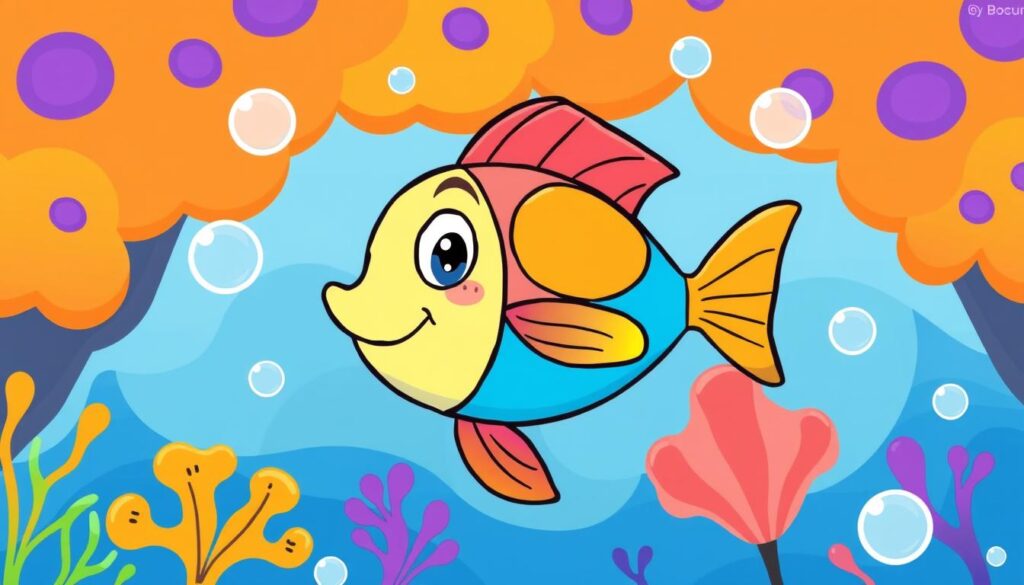
Bringing your fish art to life doesn’t stop at the sketching stage. To truly capture the beauty and depth of your underwater subject, mastering coloring and shading techniques is key. Whether you’re creating a vibrant, colorful fish or a more subtle, monochromatic design, the right approach to coloring and shading can make all the difference.
Start by selecting a color palette that complements the natural hues of your fish species. Bluegills, for example, are known for their stunning mix of blues, greens, and oranges. Experiment with different media, such as colored pencils, markers, or even digital painting tools, to bring these colors to life on the page.
| Coloring Technique | Description |
|---|---|
| Layering | Build up colors by applying multiple layers, allowing each layer to dry before adding the next. This creates depth and dimension. |
| Blending | Smoothly transition between colors by gently blending the edges, creating a seamless gradient. |
| Stippling | Use a series of tiny dots or points to fill in areas, creating a textured effect that mimics the look of fish scales. |
Shading is another essential technique for adding depth and realism to your fish drawing. Experiment with methods like cross-hatching, where you create intersecting lines to create shadows and highlights, or stippling to create a subtle gradation of tone. Pay close attention to the fish’s anatomy, observing how light and shadow play across the curves and contours of the body.
Remember, the key to mastering coloring and shading is practice. Experiment with different techniques, materials, and color palettes to find the approach that best suits your artistic style and the fish you’re aiming to capture. With patience and dedication, you’ll be able to bring your fish drawings to life in vivid, eye-catching detail.
Creating an Underwater Scene with Your Fish Drawing

Now that you’ve learned to draw a great fish, it’s time to add more to your art. You’ll learn how to add seaweed, bubbles, and other sea creatures. This will make your fish drawing come alive in a colorful, three-dimensional world.
Start by using art tools like the Tombow 12 New Dual Brush Pens or the 10 Pack Tropical Set. These markers make it easy to add colors and textures. Also, the Tombow Mono Drawing Pencil, Tombow Glue Pen, Tombow Mono Eraser, Tombow Mono Drawing Pen (size 01), and the Tombow Fudenosuke Brush Pen are key for your project.
First, sketch out your underwater scene. Think about where to put the fish, bubbles, seaweed, and other sea creatures. Use perspective and depth to make it look real. Be patient and let the ink dry before erasing or adjusting. The Tombow glue pen is great for adding sparkly touches, like fish scales or bubbles.
Remember, the most important thing is to have fun. Let your imagination run wild. You might create something that marine life lovers everywhere will adore. Whether they enjoy fun fish art projects, fish doodle guides, or drawing marine life easily, your art could touch their hearts.
how to draw a fish easy for Beginners
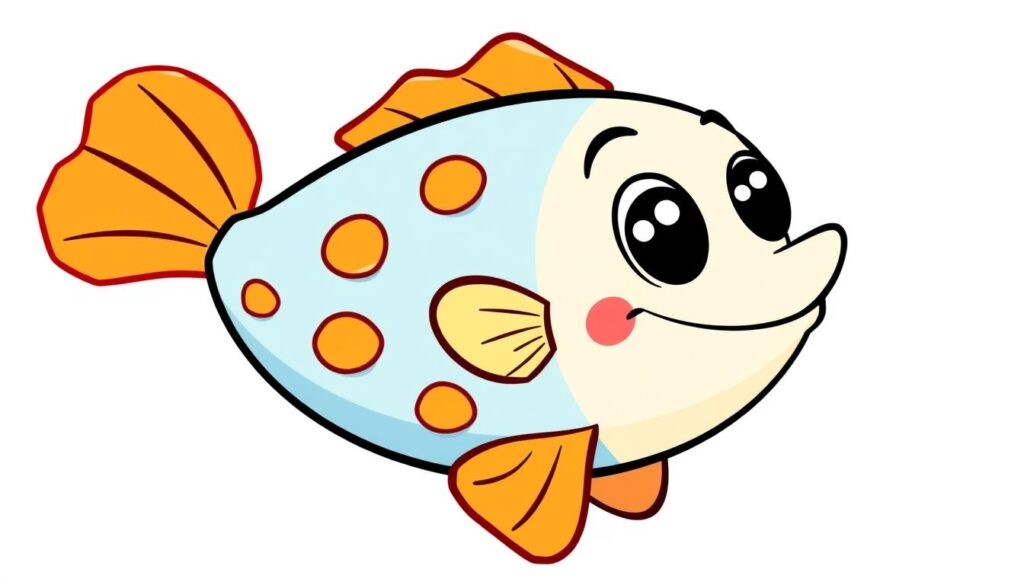
If you’re new to drawing and want to learn how to draw a fish, you’re in the right spot. Drawing a fish might seem hard, but it’s easy with a few simple steps. Just focus on the basic shapes that make up a fish’s body.
To start, get your drawing tools ready. You’ll need pencils, pens, and a sketchbook. The Sakura Pigma Micron pens and a Canson Mixed Media Sketchbook are great choices. They help you make a clean, detailed fish drawing.
First, draw the fish’s body shape, like an oval or oblong. Then, add the tail, fins, and eye. Don’t worry if it’s not perfect at first. The more you practice, the better you’ll get at drawing simple fish art.
Remember, the most important thing is to have fun and be creative. With patience and practice, you’ll be amazed at the beautiful fish illustrations you can make.
So, pick up your pencils and start drawing fish. Follow these easy steps and practice a bit, and you’ll soon be creating amazing fish drawings.
Tips for Improving Your Fish Drawing Skills
As you get better at drawing fish step by step, keep working on your skills. Drawing fish well means knowing their body and how they move. By using certain techniques, you can make your fish drawings more lively and detailed.
Try drawing fish in different poses and from different angles. This helps you capture their movement and beauty. Watching real fish in aquariums or documentaries can also teach you a lot about them.
Using different drawing tools can also improve your fish drawings. Try colored pencils, watercolors, or digital tools to add color and texture. Play with different strokes and layers to find your own style.
Focus on the small details that make a fish look real. Pay attention to the fin rays, scale patterns, and the shape of their mouth and eyes. Getting these details right will make your fish drawings look more real and engaging.
Improving your fish drawing skills takes time and effort. Keep exploring, trying new things, and learning. With hard work and practice, you’ll make your fish drawings come to life and show off your talent.
Inspiring Examples of Fish Drawings
Let’s end our journey on how to draw fish by admiring some amazing drawings. These pieces range from playful to incredibly realistic. They show the endless possibilities in drawing marine life easily.
There’s a collection of fish wearing fun accessories like sunglasses and chef hats. These drawings show off skill and a sense of humor. They also capture the lively nature of sea creatures.
The article also shares a variety of fish species, like angelfish and whale sharks. Each drawing focuses on the unique traits of its subject. This lets artists dive into the rich world of the ocean. Whether you’re experienced or new to fish art, these examples will surely inspire and amaze you.
